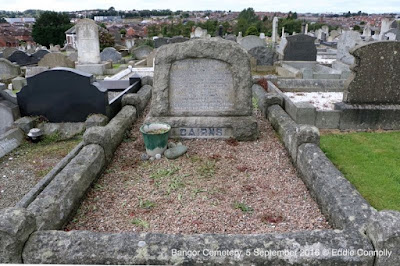Died: 28/06/1926
Age: 36
Remembered on family memorial in Bangor cemetery
Percival Cairns was born in, Glasgow on 22nd August 1889, the third son of James Cairns, a police constable (later police inspector) and his wife Mary Cairns nee McKeown, who came from Belfast. He studied at Glasgow School of Art from 1905 to 1912 and married Christina Elliot McAllister in 1914.
He enlisted in the Royal Artillery and served with the 3rd Lowland Howitzer Brigade and transferred to the Royal Flying Corps at the beginning of 1918. He was discharged in the end of 1919.
After the war he returned to his occupation as an architect and went in to partnership with Neil Campbell Duff. He died on 28th June 1926 of pulmonary tuberculosis.
A biography of his career is given below.
From the Mackintosh Architecture archive in University of Glasgow.
Percival Cairns was born in Springburn, Glasgow in 1889. He attended the Glasgow School of Art from 1906-7 until 1910-11, while also engaged as an apprentice to Honeyman, Keppie & Mackintosh from April 1909 to April 1910. He is recorded in the 1911 census as an 'architectural draughtsman'.
Cairns became an associate member of the Glasgow Architectural Institute around 1913. The Glasgow Post Office Directory gives his office as 108 Douglas Street (an address shared by architect Robert J. Walker), while another entry lists '136 Wellington Street'; no. 136 was also shared with other practices, including John A. W. Grant. It is thought that Cairns may have been articled to Neil Campbell Duff between 1905 and 1912, but it is not till 1914 that there is firm evidence of him working as Duff's assistant.
Duff had an unusual specialism: the production of scenes of crime, or 'locus' plans, for legal firms and as evidence for courts. Examples from Cairns's time include a murder site at Sheildhall timber wharf (1914), and an arson-damaged shop in Partick (1915). Duff concentrated on the entertainment industry, frequently as part of a syndicate which identified sites for potential development into dance halls or cinemas. The syndicate would form a joint-stock company with a public share issue, thus raising capital to fund the construction. Among Duff's projects on which Cairns was probably employed was the planned Regent Hotel and Picture House in Sauchiehall Street, advertised in December 1913.
After renting a house at Oxford (now Oban) Drive, Kelvinside, in 1915, Cairns vanishes from the records until 1919, possibly due to war service. Around 1919, Duff took Cairns into partnership, and the title of the firm reflects this from 1920. A further share-issue was made in 1921, to fund their jointly-signed design, the 'Palais de Danse' hall at Eglinton Toll, specifically chosen to be near major tram interchanges in southern Glasgow. Cairns died in 1926.

No comments:
Post a Comment